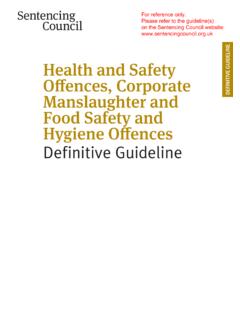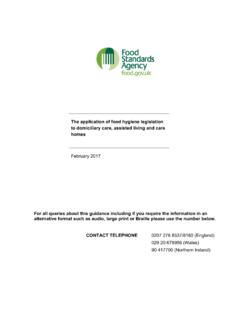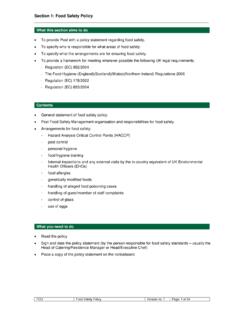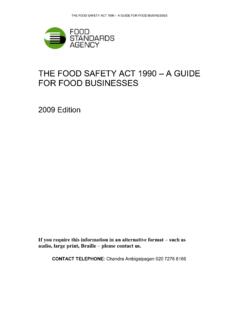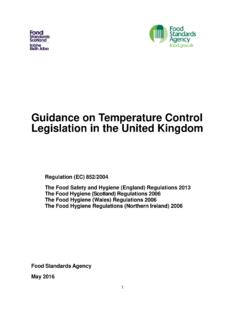Transcription of The Powers of the Environmental Health Officer
1 The Society of food hygiene and Technology Legislation The Powers of the Environmental Health Officer INTRODUCTION. The food Safety Act 1990 was introduced following growing public concerns over a catalogue of food related scares and in particular the rising incidence in reported cases of food poisoning. The regulations for food hygiene within non-approved premises in the European Union are Regulation (EC) 852/2004. It lays down general food hygiene legislation for member states. Devolution has allowed each country in the to have their own set of regulations ; The food hygiene ( england ) regulations 2006 with equivelent regulations in Scotland, Wales and Northern Ireland. Each country has its own food Law Code of Practice. Responsibility for enforcement of the Act and regulations is vested in local authorities. They in turn appoint Environmental Health Officers (EHOs) and Trading Standards Officers (TSOs) who have extensive Powers of investigation and control.
2 These Powers are considered under three headings: Entry into premises Control of premises Sampling 2008. The Society of food hygiene and Technology Legislation The Powers of the Environmental Health Officer ENTRY INTO PREMISES. This is covered in Sections 32 & 33 of the Act. The local authority will maintain a register of all the food premises registered in their district and will have planned an inspection programme. An EHO, as an authorised Officer , has the right to enter any premises at all reasonable hours, to ascertain whether there is or has been any contravention of the Act or regulations made under it. The phrase any premises can include the administrative offices and laboratories of a firm if this is where quality control or sales records are held. The EHO is able to enter premises outside his district to follow a chain of production and distribution, but only in connection with an investigation regarding food processed or sold in his own district, and he is not able to take any enforcement action such as seizing food .
3 In these circumstances, the EHO is advised to contact the local authority if practicable, as he will require their assistance or presence to take enforcement action in the disrtict where the premises are situated. If the EHO is refused entry, or has reason to believe he will be refused, or if the premises are closed, he can apply to a magistrate for a warrant to enter, if necessary by using reasonable force. Normally the occupier will be given notice of intention to apply for a warrant but this step may be omitted if the magistrate is satisfied that to do so would defeat the object of the entry or if the owner is absent. In such cases the EHO may be accompanied by a police Officer and other persons such as technicians authorised by Local Authority. When he leaves, the EHO must make sure that the premises are as secure as they were before entry was made. 2008. The Society of food hygiene and Technology Legislation The Powers of the Environmental Health Officer The EHO will normally wear the clean protective clothing and headgear provided by the local authority but, where there are strict hygiene controls regarding personal hygiene and protective clothing, the EHO should ensure that he wears the appropriate protective clothing provided by the company and adheres to any reasonable food safety precautions required by the company.
4 When in the premises, the EHO can ask to see various records relating to the business, including computer records, which may have to be made available in hard copy to take away. He can question staff and take photographic and video evidence. The records could include production records relating to HACCP procedures such as process control and cleaning schedules, or commercial records showing where products had been sent. It is an offence to obstruct the EHO in his enquiries or to give him false or misleading information. However no person is required to answer any question or give any information, if to do so, might result in self-incrimination. The EHO is advised to use his discretion when inspecting process records and it is an offence for him to disclose any trade secrets he may learn in the course of his inspection. Although it is necessary for unannounced routine inspections to take place, it is often advantageous for some visits to food firms to be announced.
5 This allows appropriate members of the management staff to be available with the necessary documentation. The inspecting Officer should be made aware of the food safety systems in place at that establishment. 2008. The Society of food hygiene and Technology Legislation The Powers of the Environmental Health Officer CONTROL OF PREMISES. This is covered in Sections 10, 11 & 12 of the Act and Regulation 6 using hygiene Improvement Notices, and Regulation 8 using hygiene Emergency Prohibition Notices. food Law Code of Practice: Chapter hygiene Improvement Notices. Chapter Prohibtion Procedures Chapter Seizure and Detention Where, as a result of a planned inspection, or the investigation of a complaint, the EHO considers that food premises or their operation are unhygienic, and the proprietor is uncooperative, he may take one of the following courses of action:- Serve a hygiene Improvement Notice;. Seek a conviction which may result in a Prohibition Order.
6 Serve a hygiene Emergency Prohibition Notice, followed by an application to a Magistrates Court for a hygiene Emergency Prohibition Order. The Improvement Notice is a well-established procedure in food hygiene enforcement. It must be specific, stating those items, which the EHO. considers require attention, the grounds for issuing the notice, and the action which the proprietor needs to take. There is a time limit (not less than 14 days). in which action must be taken or the notice may be appealed against. If the EHO then considers that adequate action has not been taken, legal proceedings may be instituted at which the proprietor may challenge the validity of the notice. Before such actions are put in place the EHO should be mindful of the food Law Code of Practice. 2008. The Society of food hygiene and Technology Legislation The Powers of the Environmental Health Officer If a proprietor is convicted of an offence against the food Safety Act or regulations , and the court thinks that public Health is at risk, it must impose a hygiene Prohibition Order.
7 This can prohibit the use of a process, equipment or premises for the existing business, or for any food business according to the circumstances. This section makes it possible for the EHO to target a specific product if he considers that the production method is unsafe. It can also prohibit the proprietor from operating the existing and/or any other specified class of business. A Prohibition Order against premises can be revoked by a certificate issued by the local authority on the advice of the EHO. A Prohibition Order against a person can only be revoked by the court. If an EHO believes that a food business represents an imminent risk to Health , he can serve on the proprietor a hygiene Emergency Prohibition Notice and display a copy in a conspicuous position on the premises, prohibiting the continuance of the business. Within three days, the authority must apply to a magistrate for a hygiene Emergency Prohibition Order, which may be opposed at the hearing by the food business.
8 If it is not confirmed, the notice lapses and the proprietor can claim compensation for any loss. If it is confirmed, again it is served on the proprietor and a copy displayed on his premises. It can only be revoked by a certificate issued by the EHO when he considers there is no longer a risk to Health . As soon as the proprietor believes that he has taken appropriate measures to remove the Health risk, he can himself ask the local authority to recognise this and to issue a certificate and remove the order. They have to give a decision within 14 days and if they refuse a certificate, tell him why. The hygiene Emergency Prohibition procedure is a very powerful weapon in the armoury of the EHO. 2008. The Society of food hygiene and Technology Legislation The Powers of the Environmental Health Officer SAMPLING. This is covered by Sections 29, 30 & 31 of the Act, by The food Safety (Sampling and Qualifications) regulations 1990 and by the food Law Code Section The EHO has the power to take samples for analysis - composition/labelling by a Public Analyst, or (microbiological) examination by a food Examiner.
9 Such samples may be taken or purchased , the EHO being advised to at least make an ex-gratia payment if the scale or frequency of the sampling will have significant financial consequences to the owner of the food . Only officers who have been properly trained in the appropriate techniques should take samples to ensure that they are representative and not contaminated. Samples may include food , which appears to the EHO to be intended for sale, ingredients, or contact material. They may be taken during an inspection, as part of a survey or in connection with an investigation into an alleged offence. The EHO should take full details of the samples including the date code or batch number. The owner of the food has to be informed that a sample has been taken. The EHO also has to inform the manufacturer, if this is not the owner, referring to the address given on the packaging of the food . Both owner and manufacturer are then entitled to ask for the result of analysis or examination when available.
10 Samples for analysis have to be divided into three, except where this is impracticable, three containers of carbonated soft drinks. One sample is sent to the Public Analyst, one is given to the owner for him to have analysed by his own laboratory, the third is retained by the EHO in case of dispute when it is analysed by the Government Chemist. TSOs are usually responsible for this type of sampling. 2008. The Society of food hygiene and Technology Legislation The Powers of the Environmental Health Officer Samples for examination do not have to be divided into three as it is not possible to ensure homogeneous distribution of any bacterial contaminants. In such cases it would be prudent for the owner/manufacturer to take a sample of product at the same time for examination by his own laboratory. Products taken for examination have to be transported to the food Examiner at the appropriate temperature to avoid changes in the bacterial population, and examined within four hours of sampling, preferably within two hours.


